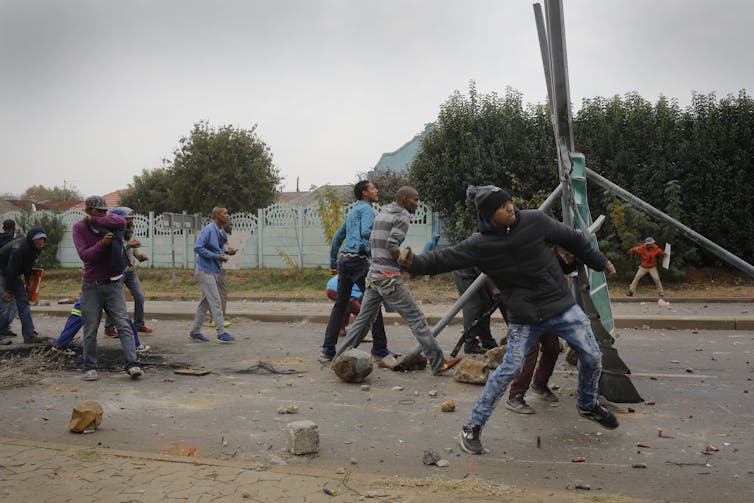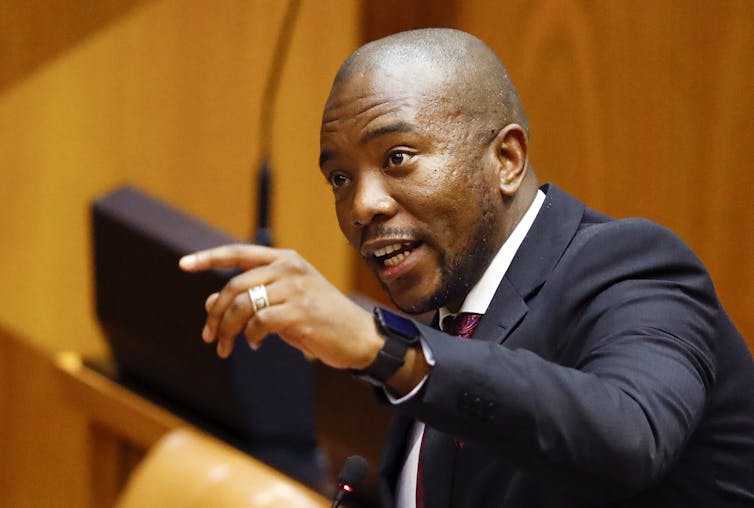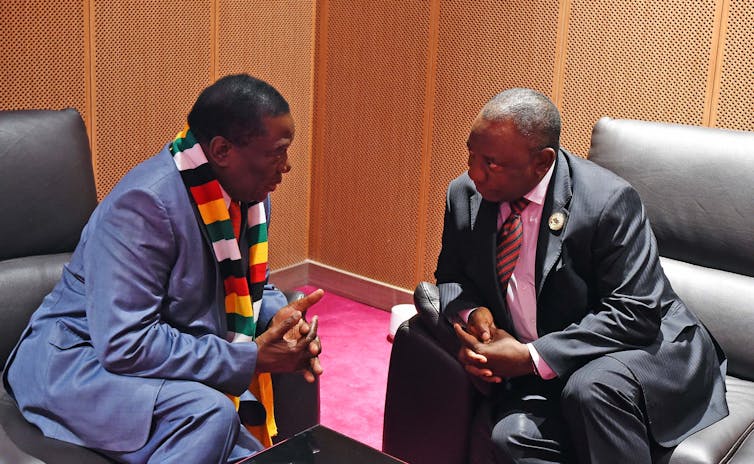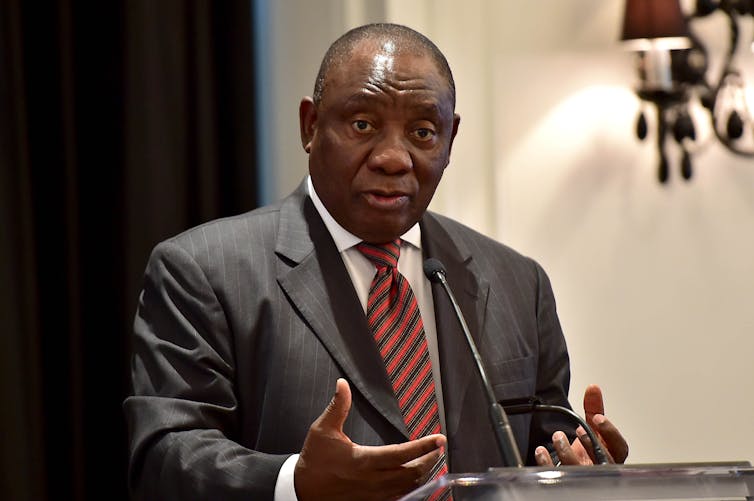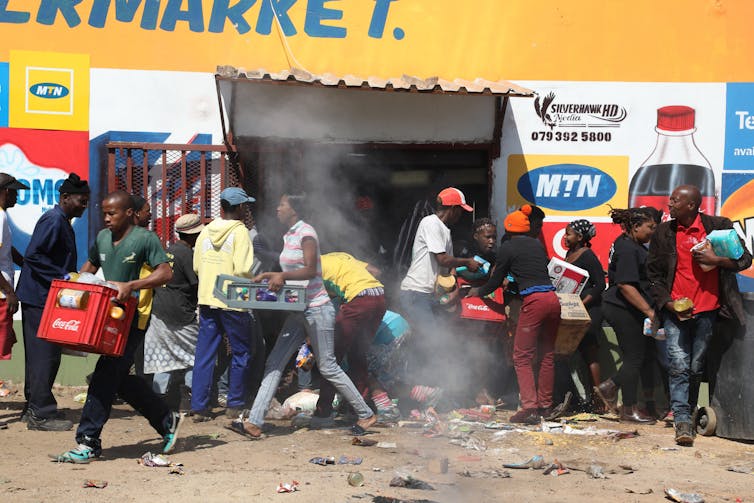
Four people died in the latest violence and looting to hit shops owned by foreign nationals in Soweto, Johannesburg.
Sowetan/Thulani Mbele
Foreign nationals have, yet again, been attacked, displaced and had their shops looted in South Africa. This is an unfortunate – but entirely unsurprising – way to mark the anniversary of the 2008 xenophobic attacks during which tens of thousands were displaced and more than 60 people killed.
Even before 2008, a handful of scholars and activists were urging the government to do more to protect those targeted for violence because of their geographic origins. Only after the 2008 melee did the government join civil society and international organisations in committing to ensure that such bloodletting would never happen again. But, it has.
Why? Firstly, both the government and civil society are culpable. The government continues to sideline xenophobic violence the same way it does most violence affecting poor South African communities. It has naturalised anti-outsider violence by blaming it variously on criminality or the natural resentment poor South Africans feel towards those they perceive as “stealing” opportunities from them.
Civil society efforts have fared little better in arresting the violence. Many organisation, foreign and domestic, have responded in a classic “garbage-can” fashion, matching ready-made solutions to problems they only poorly understand. The results include innumerable marches, education campaigns, rights awareness symposiums, and social cohesion summits. Various bodies, including the one I work for, regularly document the abuse of migrants at the hands of police, authorities and neighbours.
The solution doesn’t lie in simply doing more of the same. What’s required is to recalibrate how xenophobia is covered, particularly how stories are told about migrants – their rights, suffering, and their relationship to the citizens around them. The way it’s currently done is doing more harm than good.
South African coverage of migrants falls into what the president of the global Ethical Journalism Network, Aidan White, recently noted was a trend towards “victim journalism” in global migration coverage.
But changing course means going against the grain of the dominant narratives. It means destabilising the language and approaches used to speak about violence and immigration. This is as true in South Africa as it is elsewhere in the world.
When one does this, as Tanya Pampalone and I have tried to do in the book I Want to Go Home Forever: Stories of Becoming and Belonging in Africa’s Great Metropolis. the stories are often difficult to digest. They are uncomfortable because they upset easy binaries and accusations. They also point to new opportunities to build communities that are inclusive and safe.
Victim journalism
The accounts of migrants described in White’s article are very recognisable in South Africa. Many of the accounts offered by South African civil society and scholars rapidly descend into a parade of miseries and indignities. As if the more people suffer, the more deserving they are of not only sympathy, but a place in a hosting country. It’s as if the only way one is allowed to stay is if you completely deserve pity.
Miriam Ticktin, a leading migration scholar, similarly observes how migrants need to ensure they are read as helpless, needy and innocent to secure access to protection and help. While such claims may get you “in”, they also feed perceptions that migrants are wards, stealing resources.
The problem of focusing on migrants’ rights and victimisation is that it does little to hold the political and criminal elements leading – and benefiting – from the violence against migrants responsible. It also prevents empathy from citizens grappling with the competition for scarce resources such as houses, or for jobs, as well as the ethical dilemmas of migration. Migration is a complex process that by its nature transforms communities. It introduces new languages and customs. It creates new forms of economic and social exchange. These can be unsettling and disorienting, especially during times of economic hardship and political transition.
Framing xenophobic violence as a question of immigrant victimisation invites divisions between neighbours. There are multiple examples, such as accounts of immigrants as somehow superhuman people who have suffered violence and persecution across a smorgasbord of sites, yet heroically continue commerce to feed their families.
Journalists and scholars overlook or suppress unsavoury elements of migrants’ histories and activities. This is often for fear of feeding anti-immigrant reactions. Perhaps more importantly, migrant-oriented journalists and activities too quickly condemn South Africans as thoughtless purveyors of violence.
Both sides become caricatures, people without politics or the complexities that are inherent to all humans.
Humanising migration
It’s true: there are many stories of victimisation. But there are a host of other accounts that reflect a complexity often ignored in the simple narratives.
There are the geriatric refugees from Ethiopia who fear reprisals for political actions taken decades ago. There are conflicts among immigrant families far more vicious than anything South Africans are offering. There are immigrants who make court cases against them disappear.
There are also thoughtful, patriotic South Africans convinced xenophobia is socially just. For them, overcoming apartheid’s legacy means redirecting resources and opportunities to the citizens who most suffered from it. For them, sharing the country’s wealth and urban space with “others” can only frustrate a transformation agenda that has been too slow to bear fruit.
There are also stories – seldom told – that can salve and offer direction. They remind those willing to listen that while immigrants live in almost all South African townships, violence against them is remarkably infrequent. It’s not random or driven solely by rage, but calculated, purposeful, and directed.
What is more, there are poor, black South Africans who know that foreigners are not the problem. They are perfectly aware that foreigners aren’t the reason they are jobless, homeless, and frightened to walk the streets. Better than most, they know that it is officials’ false promises and unwillingness to counter corruption, violence, incompetence and institutional incapacity that are to blame.
These are problems with no easy solutions. Yet that is precisely the message that scholars, activists, and concerned citizens need to hear.
Loren B Landau, Research Chair on Mobility & the Politics of Diversity. Migration; Urbanisation; Refugees; Xenophobia, University of the Witwatersrand
This article is republished from The Conversation under a Creative Commons license.
